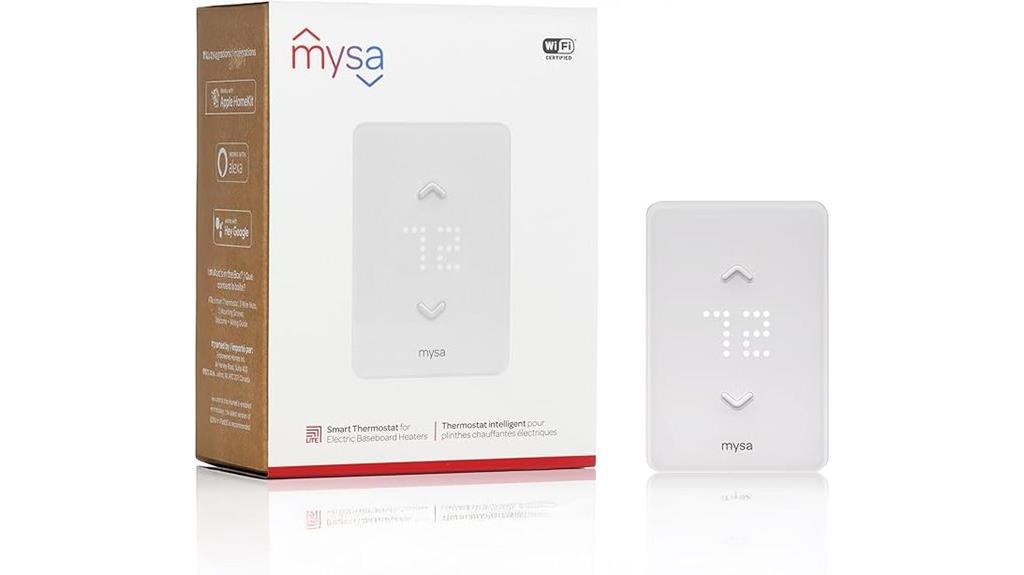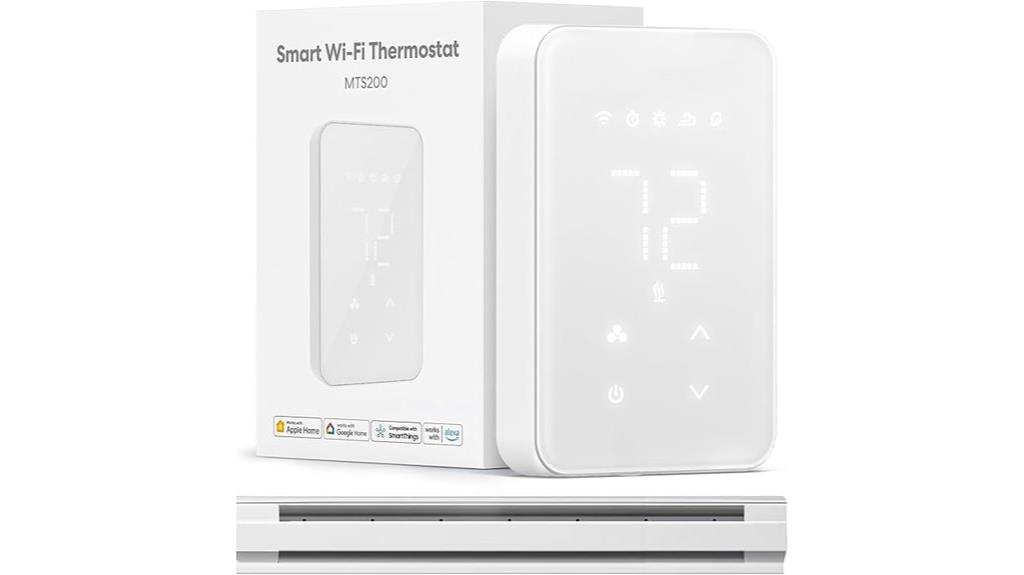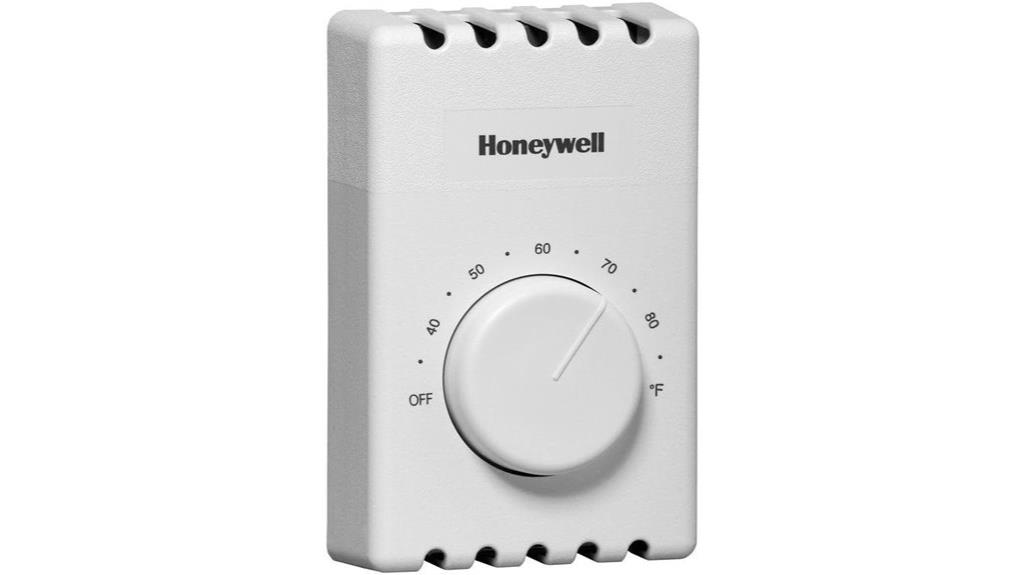If you’re looking for the best smart thermostats for baseboard heaters, I recommend checking out options like Mysa, MOES, and meross, which offer easy installation, compatibility with major smart home platforms, and energy-saving features. Many models include displays, scheduling, and remote controls to keep your home cozy and efficient. Budget and specific system compatibility matter, so exploring these choices helps you find the perfect fit. Keep going to discover detailed insights on each option.
Key Takeaways
- Compatibility with 120-240V systems and major smart home platforms ensures seamless integration for baseboard heater control.
- Features like scheduling, geofencing, and energy monitoring optimize comfort and reduce heating costs.
- Easy DIY installation with clear wiring instructions makes setup accessible for most users.
- Precise temperature regulation and reliable Wi-Fi connectivity ensure consistent, efficient heating performance.
- Sleek designs with LCD displays and app control offer user-friendly operation and remote management.
Mysa Smart Thermostat LITE for Electric Baseboard Heaters

If you’re looking for a sleek, easy-to-install smart thermostat that specifically controls high-voltage electric baseboard heaters, the Mysa Smart Thermostat LITE is an excellent choice. It supports 120-240V electric baseboards and fan-forced heaters, requiring at least four wires, including neutral or a second live wire. Designed for quick DIY installation—usually under 30 minutes—it replaces existing thermostats effortlessly. Its modern, compact design fits seamlessly into any space, and it connects via Wi-Fi for remote control through the Mysa app. With compatibility with Apple HomeKit, Alexa, and Google Assistant, it offers both convenience and smart home integration, all while helping you save energy.
Best For: homeowners seeking a sleek, easy-to-install smart thermostat specifically designed for high-voltage electric baseboard heaters and integrated with major smart home systems.
Pros:
- Simple DIY installation typically under 30 minutes with clear guidance
- Compatible with Apple HomeKit, Alexa, and Google Assistant for voice control and automation
- Energy-saving features that can reduce heating costs by up to 26%
Cons:
- Requires at least four wires, including neutral or second live wire, limiting compatibility with some older wiring setups
- Occasional temperature reading inaccuracies or desyncs with third-party apps, which may need troubleshooting
- Bluetooth setup can be challenging for some users, necessitating online account creation for full functionality
meross Smart Thermostat for Electric Baseboard and In-Wall Heaters

The meross Smart Thermostat stands out as an excellent choice for homeowners with electric baseboard or in-wall heaters who want reliable, precise temperature control and smart home integration. Supporting 120V-240V systems with up to 16A load, it’s compatible with various electric heating systems, excluding underfloor heating. Its 1°F accuracy and scheduling features help save energy and maintain comfort. Easy to install within 30 minutes, it connects seamlessly with Apple HomeKit, Alexa, Google Assistant, and SmartThings. The sleek LCD display and app control offer convenient remote adjustments. Overall, it’s a reliable, modern solution for smart, efficient heating management.
Best For: homeowners seeking a reliable, smart thermostat for electric baseboard or in-wall heaters with easy installation and seamless smart home integration.
Pros:
- Supports 120V-240V systems with up to 16A load, making it versatile for various electric heaters.
- Compatible with popular smart home platforms like Apple HomeKit, Alexa, Google Assistant, and SmartThings for voice and remote control.
- Features precise 1°F temperature accuracy, scheduling, energy monitoring, and open window detection for energy efficiency.
Cons:
- Does not support underfloor heating systems despite some claims.
- The display only shows current room temperature, not the set temperature, requiring app access for full control.
- Custom mounting may be needed if wiring is limited, which could complicate installation for some users.
Mysa Smart Thermostat for Electric Baseboard Heaters

For homeowners with high-voltage electric baseboard heaters seeking a seamless, smart heating solution, the Mysa Smart Thermostat stands out. It’s designed specifically for 120–240V systems, supporting loads up to 3800W at 240V, and requires at least four wires, including a neutral or second live wire. The sleek, wall-mountable device offers Wi-Fi, NFC, and compatibility with Apple HomeKit, Alexa, and Google Assistant. It features adaptive brightness, energy insights, geofencing, scheduling, and remote control via app or voice commands. Installation is quick, and users report reliable performance, energy savings, and easy integration into existing smart home setups.
Best For: homeowners with high-voltage electric baseboard heaters seeking a smart, energy-efficient, and easy-to-install thermostat solution.
Pros:
- Compatible with 120–240V electric heating systems supporting loads up to 3800W at 240V.
- Features adaptive display, energy insights, geofencing, scheduling, and easy app control.
- Sleek, unobtrusive design that blends well with light-colored walls and simple installation process.
Cons:
- Requires at least four wires, including a neutral or second live wire, making it unsuitable for two-wire setups.
- Some users experience minor UI quirks or initial Wi-Fi connection challenges.
- Not compatible with low-voltage systems or two-wire installations.
MOES Programmable Smart Thermostat for Electric Heaters

Designed specifically for electric baseboard heaters, the MOES Programmable Smart Thermostat offers seamless control through its WiFi connectivity and compatibility with popular smart home platforms like Alexa, Google Home, and TUYA/Smart Life. I love how I can remotely manage my heating via smartphone, ensuring comfort even when I’m away. It supports high-voltage systems with at least four wires, including a neutral or second live wire, making installation straightforward for most setups. The frosted display reduces glare, and the easy-grip knob allows manual adjustments easily. Plus, I’ve saved up to 23% on energy costs by scheduling heating only when needed.
Best For: homeowners and property managers seeking an energy-efficient, easy-to-install smart thermostat for electric baseboard heating systems.
Pros:
- Supports remote control and scheduling via WiFi, compatible with Alexa, Google Home, and TUYA/Smart Life app.
- Designed for high-voltage systems with easy installation using at least four wires, including neutral or second live wire.
- Frosted display reduces glare for clear visibility and features an easy-grip knob for manual adjustments.
Cons:
- Requires a compatible wiring setup with at least four wires, which may not be available in older electrical boxes.
- Primarily designed for electric baseboard heaters; may not be suitable for other heating systems.
- Reliance on WiFi connectivity means performance could be affected by network issues.
Mysa Smart Thermostat for Electric In-Floor Heating

If you’re looking to upgrade your electric in-floor heating system with a sleek and reliable smart thermostat, the Mysa Smart Thermostat stands out as a top choice. Designed for 120-240V systems, it supports up to 3800 watts and features a built-in GFCI for safety. With Wi-Fi connectivity, you can control it remotely via app or voice assistants like HomeKit, Alexa, and Google Home. Installation is simple, and its modern design with an LED display looks great on any wall. It offers programmable schedules, vacation mode, and energy insights, helping you save on electricity while keeping your floors consistently cozy.
Best For: homeowners seeking a stylish, easy-to-install smart thermostat to remotely control and optimize their electric in-floor heating system.
Pros:
- Sleek modern design with LED display that complements contemporary interiors
- Easy installation process with clear instructions and wall-mounting hardware
- Supports Wi-Fi connectivity and voice control via HomeKit, Alexa, and Google Home for convenient remote management
Cons:
- Compatibility issues may arise with certain routers or network configurations, requiring troubleshooting
- Initial heating delays can occur depending on the floor system and setup
- Some users report device failures within 18 months, though customer support is generally helpful
Wi-Fi Smart Thermostat for Electric Baseboard Heaters

A Wi-Fi smart thermostat for electric baseboard heaters offers convenient remote control and scheduling, making it ideal for homeowners who want easy temperature management from anywhere. It supports 120-240V systems and features a Fahrenheit LCD display showing current temperature, target setting, time, and Wi-Fi status. Easy to install with a proprietary wall plate, it connects via 2.4 GHz Wi-Fi and works with Alexa and Google Assistant. You can customize schedules, control the heater remotely, or use voice commands. While setup is straightforward, some users encounter Wi-Fi connectivity issues or display brightness concerns. Overall, it’s a versatile option for maintaining comfort and efficiency in your home.
Best For: homeowners seeking easy remote control and scheduling for electric baseboard heaters, especially those with Wi-Fi capability and voice assistant integration.
Pros:
- Supports 120-240V systems, suitable for electric baseboard heaters and heated floors
- Easy to install with proprietary wall plate and quick setup process
- Compatible with Alexa and Google Assistant for voice control
Cons:
- Some users report Wi-Fi connectivity issues and manual setup difficulties
- Display brightness and manual readability may be limited or inconsistent
- Inaccurate temperature readings, often about 9°F higher than actual temperature
Electric Thermostat with LCD Display for Electric Heaters

Electric thermostats with LCD displays are ideal for users seeking precise and reliable temperature control for their electric heaters. They feature an accuracy of ±1℃ and a measurement range of 0–50℃, with a set range of 5–60℃, ensuring you can fine-tune your environment. These thermostats use microcomputer control for strong anti-interference and system stability, making operation smooth and dependable. The clear LCD screen is scratch-resistant, providing easy reading at a glance. Equipped with highly precise sensors, they deliver accurate temperature detection and regulation, simplifying heater management and enhancing comfort without sacrificing energy efficiency.
Best For: users seeking precise, reliable, and easy-to-read temperature control for their electric heaters in residential or commercial settings.
Pros:
- Accurate temperature measurement within ±1℃ for optimal comfort and energy efficiency
- Easy-to-read scratch-resistant LCD display enhances user convenience
- Microcomputer control provides strong anti-interference and system stability
Cons:
- Limited temperature measurement range (0–50℃) may not suit all heating needs
- Set temperature range (5–60℃) might require manual adjustments for specific environments
- Dependence on electronic components could require careful installation and maintenance
Honeywell Programmable Thermostat for Electric Baseboard Heaters

The Honeywell Programmable Thermostat for Electric Baseboard Heaters stands out for its precise temperature control and user-friendly design, making it an excellent choice for homeowners seeking reliable comfort management. It features a backlit display and straightforward instructions inside the panel, simplifying setup and daily use. With an accuracy of ±0.27°F and TRIAC switching, it ensures silent operation and consistent temperatures. The 5-2 day programming allows for tailored schedules, with four periods daily—wake, leave, arrive, sleep—giving you flexible control. Its easy installation via a 2-wire connection and temporary override function make it both convenient and adaptable for your heating needs.
Best For: homeowners seeking precise, silent, and customizable temperature control for electric baseboard heaters with easy installation and user-friendly features.
Pros:
- Highly accurate temperature control with ±0.27°F precision
- Silent operation thanks to TRIAC switching, reducing temperature swings
- Easy to install with a simple 2-wire connection and clear instructions
Cons:
- Limited to electric baseboard heaters, not compatible with other heating systems
- 2-wire setup may restrict advanced wiring options for some users
- Programming options are basic compared to more advanced smart thermostats
Honeywell TL8230A1003 Line Volt Thermostat 240/208 VAC 7 Day Programmble

If you’re seeking a reliable thermostat that offers precise control and energy savings, the Honeywell TL8230A1003 stands out for line voltage applications. It features a 7-day programmable schedule, allowing you to customize routines and ensure comfort when needed. The early start function guarantees your home reaches the desired temperature on time, boosting efficiency. Supporting up to 20% energy savings, it’s compatible with 208/240V systems and has a resistive load capacity of 15A. Its electronic system offers ±1°F accuracy, and the large backlit display makes adjustments easy. Plus, it operates without batteries, reducing maintenance concerns.
Best For: homeowners and contractors seeking a reliable, energy-efficient line voltage thermostat with programmable scheduling for 208/240V heating systems.
Pros:
- Offers a 7-day programmable schedule for customized comfort routines.
- Supports energy savings of up to 20% through optimized scheduling and early start feature.
- Large, backlit display and electronic precision of ±1°F for easy operation and accurate temperature control.
Cons:
- Requires a 4-wire, double pole setup, which may not be compatible with all existing wiring.
- Limited to resistive load applications up to 15A, restricting use with certain high-power devices.
- No battery backup, so it depends solely on line power, which could affect operation during power outages.
Amazon Smart Thermostat

For homeowners seeking a seamless upgrade from traditional thermostats, the Amazon Smart Thermostat stands out with its easy installation and compatibility with C-wire systems. It works effortlessly with Alexa and Ring devices, allowing voice commands and smart home integration. Compatible Echo devices, like the Echo Dot (4th and 5th gen) and Amazon Smart Air Quality Monitor, can serve as temperature sensors to address hot or cold spots. Using ENERGY STAR certified technology, it helps save around $50 annually on energy bills. The Alexa app guides setup, and remote control makes adjusting your home’s temperature simple from anywhere, ensuring comfort and efficiency.
Best For: homeowners looking for an easy-to-install, energy-efficient smart thermostat that integrates seamlessly with Alexa and Ring devices.
Pros:
- Supports C-wire connection for straightforward installation
- Compatible with popular Echo devices and smart home systems
- Helps save approximately $50 annually on energy bills using ENERGY STAR technology
Cons:
- Requires a C-wire for proper installation, which may not be available in all homes
- Limited to smart home ecosystem integration with Alexa and Ring devices
- May require assistance from customer support during setup for some users
ecobee Smart Thermostat Premium with Sensors and Air Quality Monitor

Designed for homeowners who prioritize energy efficiency and environmental health, the ecobee Smart Thermostat Premium with Sensors and Air Quality Monitor offers advanced features to optimize comfort and safety. It can save you up to 26% annually on heating and cooling costs, thanks to its smart sensors that adjust temperatures in key rooms, reducing hot and cold spots. The built-in air quality monitor alerts you to poor air conditions and reminds you to change filters. Plus, its home monitoring hub detects smoke and sudden temperature drops, providing safety alerts. With a sleek design, vibrant display, and voice control options, it’s a smart, eco-friendly upgrade for any home.
Best For: homeowners seeking an energy-efficient, environmentally friendly smart thermostat with advanced air quality and safety features.
Pros:
- Saves up to 26% annually on heating and cooling costs, reducing energy expenses.
- Built-in air quality monitor and safety alerts for improved home health and security.
- Compatible with most 24VAC HVAC systems and supports voice control via multiple platforms.
Cons:
- Requires an Apple Home Hub for Siri voice integration, adding extra setup.
- May need a subscription for certain features like SmartSensor alerts for open doors/windows.
- Installation might be complex for some DIYers despite the Power Extender Kit.
Sensi Lite Smart Thermostat

Looking to upgrade your baseboard heater control with a smart, user-friendly thermostat? The Sensi Lite Smart Thermostat is a great choice. It’s Wi-Fi-enabled, compatible with most HVAC systems, and easy to install yourself with built-in leveling tools and step-by-step instructions. It helps you save around 23% on energy costs through flexible scheduling, geofencing, and remote control via a mobile app. Plus, it’s Energy Star certified, so it’s efficient and eco-friendly. The thermostat values your privacy—your data isn’t sold or used for targeted ads. With control from anywhere, you’ll enjoy greater convenience and smarter energy management.
Best For: homeowners seeking an easy-to-install, energy-efficient smart thermostat compatible with most HVAC systems and looking for remote control and scheduling features.
Pros:
- Easy DIY installation with built-in level and step-by-step instructions
- Helps save approximately 23% on HVAC energy costs through smart features
- Compatible with most HVAC systems and works with Alexa for voice control
Cons:
- C-wire required for heat pump and heat/cool systems, not needed for most others
- Limited advanced programming options compared to more premium thermostats
- May not be suitable for systems that require specialized compatibility beyond standard HVAC setups
Honeywell Home CT410B Manual Thermostat

The Honeywell Home CT410B Manual Thermostat stands out for those who prefer a simple, reliable control method over digital programming. I appreciate its straightforward dial design, making temperature adjustments quick and intuitive. It’s compatible with electric baseboards, convectors, and fan-forced heaters at 120-240 volts, supporting loads up to 5280W. Installation is straightforward, especially with clear wiring instructions, but safety precautions are essential. Once installed, it reliably turns heaters on and off based on your settings, with no batteries or digital components to worry about. Its durability, safety certifications, and ease of use make it a solid choice for maintaining comfortable, consistent heat.
Best For: homeowners or DIY enthusiasts seeking a simple, reliable, non-programmable line voltage thermostat for electric heating systems at 120-240 volts.
Pros:
- Easy to install with clear wiring instructions and straightforward mechanical dial control
- No batteries or digital components required, reducing maintenance and potential failure points
- Compatible with a wide range of electric heaters and supports high wattage loads up to 5280W
Cons:
- Lacks digital programming features for customized scheduling or advanced control
- Temperature accuracy may require calibration with an external thermometer for precise comfort
- Mechanical operation may be less precise than modern digital thermostats, potentially leading to minor temperature fluctuations
MAXKOSKO WiFi Smart Thermostat for Electric Floor Warming System

If you want a versatile and easy-to-install smart thermostat for your electric floor heating system, the MAXKOSKO WiFi Smart Thermostat is an excellent choice. It features a touchscreen LED display, supports 120V/240V, and is compatible with most underfloor heating setups. The included 15-foot floor sensor guarantees reliable performance, while its sleek design enhances usability. With app control via Smart Life, you can adjust temperatures remotely, set schedules, and monitor energy use. Compatible with Alexa and Google Assistant, it offers voice control. Easy to install, it’s a cost-effective, modern solution that keeps your home cozy and energy-efficient.
Best For: homeowners seeking an easy-to-install, Wi-Fi-enabled smart thermostat to control their electric floor heating system remotely and efficiently.
Pros:
- Supports remote control via app, enabling convenient temperature adjustments from anywhere
- Compatible with most underfloor heating systems and easy to install with DIY instructions
- Modern, sleek touchscreen LED display with customizable scheduling and energy monitoring
Cons:
- Some users report minor wiring and compatibility issues with older electrical boxes
- Privacy concerns regarding Wi-Fi connectivity; some prefer operating in manual mode for security
- App setup and connectivity can occasionally be problematic, requiring support assistance
Factors to Consider When Choosing a Smart Thermostat for Baseboard Heaters

When selecting a smart thermostat for baseboard heaters, I consider compatibility with my heating type and how easy it is to install. I also look at smart home integration options and energy-saving features to maximize efficiency. Finally, I prioritize accurate temperature control to keep my space comfortable.
Compatibility With Heating Type
Choosing a smart thermostat that works seamlessly with your baseboard heaters requires checking its compatibility with your specific heating setup. First, verify the thermostat is designed for high-voltage systems operating at 120-240V, as low-voltage models won’t work. Confirm that it can handle the wattage and current ratings of your heaters, which typically reach up to 1900W at 120V or 3800W at 240V. Also, make sure that the device supports your heater type, whether convectors or fan-forced models, since some thermostats only support certain configurations. Additionally, check if the thermostat’s wiring and mounting options suit your existing electrical setup, especially in older homes with unique wiring constraints. Proper compatibility guarantees safe and efficient operation.
Wiring and Installation Ease
Selecting a smart thermostat for your baseboard heaters becomes much easier when you pay attention to wiring and installation requirements. Most high-voltage baseboard heaters need a thermostat that requires at least four wires, including a neutral or a second live wire. Make sure the thermostat’s wiring setup matches your existing system, whether it’s double-pole or single-pole, to avoid compatibility issues. I recommend choosing a model with clear wiring diagrams and step-by-step instructions, especially if you plan to install it yourself. Also, check if the thermostat supports your home’s wiring standards, which is important in older houses. Finally, look for thermostats that offer straightforward, tool-free mounting and minimal wiring modifications to make installation quick and hassle-free.
Smart Home Integration
Integrating a smart thermostat with your home’s automation ecosystem can substantially enhance how you control your baseboard heaters. Compatibility with platforms like Apple HomeKit, Amazon Alexa, and Google Assistant lets you use voice commands and create routines that simplify heating management. With remote access via smartphone apps, I can adjust settings anytime, anywhere, adding convenience and flexibility. Automation features, such as triggers based on occupancy or external sensors, help optimize energy use without sacrificing comfort. Many thermostats support geofencing, scheduling, and scene creation, allowing seamless climate control tailored to my lifestyle. Devices that work with multiple platforms often offer open APIs, making custom automation easier and expanding my home automation options. This integration makes managing my heating smarter and more efficient.
Energy Saving Features
Energy saving features are a key factor to contemplate when evaluating smart thermostats for baseboard heaters. Many models offer customized scheduling and eco modes, which can cut heating costs by up to 26%. Features like geofence technology and open window detection help optimize heating, turning it off when it’s unnecessary and preventing waste. Precise temperature control and remote adjustments ensure heaters don’t overheat, making your system more efficient. Energy monitoring capabilities provide real-time and historical data, helping you identify usage patterns and boost savings. Automated settings and app-based controls make it easy to adopt energy-efficient habits, reducing your overall power bills. These features collectively promote smarter heating choices, conserving energy while keeping your home comfortable.
Temperature Control Accuracy
When choosing a smart thermostat for your baseboard heaters, one of the most important factors to contemplate is its temperature control accuracy. Precise control, often within ±1°F, ensures your home stays comfortable without frequent fluctuations. High-accuracy thermostats use advanced sensors and algorithms to detect ambient temperature changes more reliably, helping maintain a steady temperature. This precision reduces the risk of overheating or underheating, which can cause discomfort and waste energy. Inaccurate readings, say 2 or more degrees off, can lead to inefficient heating and higher energy bills. A thermostat with excellent temperature control not only enhances comfort but also optimizes energy use, making your heating system more efficient and reliable over time.
User Interface Simplicity
A user-friendly interface is key to getting the most out of your smart thermostat for baseboard heaters. When controls are intuitive, I can quickly adjust settings without frustration or confusion. Clear, legible displays help me understand current temperatures and system status at a glance, saving time. Physical buttons or simple touch controls are especially helpful if I’m not tech-savvy, making operation straightforward. Quick-access presets or programmable schedules enable me to set routines effortlessly, so I don’t have to navigate complex menus every day. An uncomplicated interface minimizes mistakes and boosts confidence in managing my heating system. Overall, a simple, intuitive design ensures I get consistent comfort and efficiency without the hassle of learning complicated features.
Price and Warranty
Prices for smart thermostats for baseboard heaters can range from about $40 to over $150, depending on features and brand. While budget options may fit tight budgets, they often come with limited or no warranty, which could leave you without support if issues arise. More expensive models usually offer longer warranties, typically between 1 to 3 years, reflecting greater confidence from manufacturers in their durability and reliability. Considering both price and warranty helps you find a balance between affordability and long-term peace of mind. A higher initial investment might save you money down the line if it means better support and fewer repairs. Ultimately, choosing a thermostat with a solid warranty ensures you’re protected against unexpected faults and gets you better value for your money.
Frequently Asked Questions
Can These Thermostats Be Integrated With Voice Assistants Like Alexa or Google Assistant?
You’re wondering if these thermostats work with voice assistants like Alexa or Google Assistant. I can tell you that many smart thermostats are compatible with popular voice platforms, allowing you to control your heating with simple voice commands. I personally find it super convenient to adjust my thermostat hands-free. Just check the product details before buying to guarantee it supports your preferred voice assistant, and you’ll enjoy seamless voice control.
Do Smart Thermostats Support Multi-Zone Control for Different Rooms?
You’re asking if smart thermostats support multi-zone control for different rooms, right? I can tell you, many advanced models do! They let you set separate temperatures for each room, maximizing comfort and energy savings. With multi-zone control, I can easily customize heating in different areas of my home, avoiding wasted energy and ensuring every space stays cozy. It’s a game-changer for managing comfort efficiently across multiple rooms.
Are These Thermostats Compatible With Existing Home Automation Systems?
You’re wondering if these thermostats work with your existing home automation systems. I’ve found that many modern smart thermostats are compatible, especially those supporting popular platforms like Alexa, Google Assistant, or Apple HomeKit. However, I always recommend double-checking the specific model’s compatibility before purchasing. This way, you can seamlessly integrate them into your current setup and enjoy smarter, more convenient control over your home’s climate.
What Is the Typical Installation Process for a Smart Thermostat on Baseboard Heaters?
You’re wondering about installing a smart thermostat on baseboard heaters. Typically, I turn off the power, remove the old thermostat, and connect the new one according to the manufacturer’s instructions. I make sure to match wires properly and secure everything before turning the power back on. Some setups might need a C-wire or a compatible adapter. Overall, it’s straightforward, but I recommend consulting a professional if you’re unsure.
How Do Smart Thermostats Handle Power Outages or Connectivity Issues?
Imagine your smart thermostat as a trusty lighthouse, guiding your home’s comfort through storms like power outages or connectivity issues. When power drops, many thermostats rely on backup batteries to keep working temporarily. If Wi-Fi drops, they often switch to local controls or store settings until reconnected. Rest assured, most models are designed to maintain basic functions, so your home stays cozy even when the digital seas get rough.
Conclusion
Choosing the right smart thermostat is like finding a finely tailored suit—it’s all about the perfect fit for your home and lifestyle. Whether you prefer a simple manual model or a feature-rich WiFi-enabled device, there’s an option that’ll keep your space cozy and energy-efficient. Invest in the right thermostat, and you’ll enjoy warmth and convenience, making your home feel as comfortable as a warm embrace—even on the coldest days.









